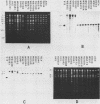Abstract
Wild-type isolates of Dictyostelium discoideum exhibited differences in the size of restriction fragments of the extrachromosomal 88-kilobase ribosomal DNA (rDNA) palindrome. Polymorphisms in rDNA also were found among strains derived solely from the NC4 wild-type isolate. These variations involved EcoRI fragments II, III, and V; they included loss of the EcoRI site separating fragments II and V and deletion and insertion of DNA. More than one rDNA form can coexist in the same diploid or haploid cell. However, one or another parental rDNA tended to predominate in diploids constructed, using the parasexual cycle, between haploid NC4-derived strains and haploid wild-type isolates. In some cases, most if not all of the rDNA of such diploids were of one form after ca. 50 generations of growth. Segregant haploids, derived from diploids that possessed predominantly a single rDNA allele, possessed the same allele as the diploid and did not recover the other form. This evidence implies that replication does not proceed from a single chromosomal or extrachromosomal copy of the rDNA during the asexual life cycle of D. discoideum.
Full text
PDF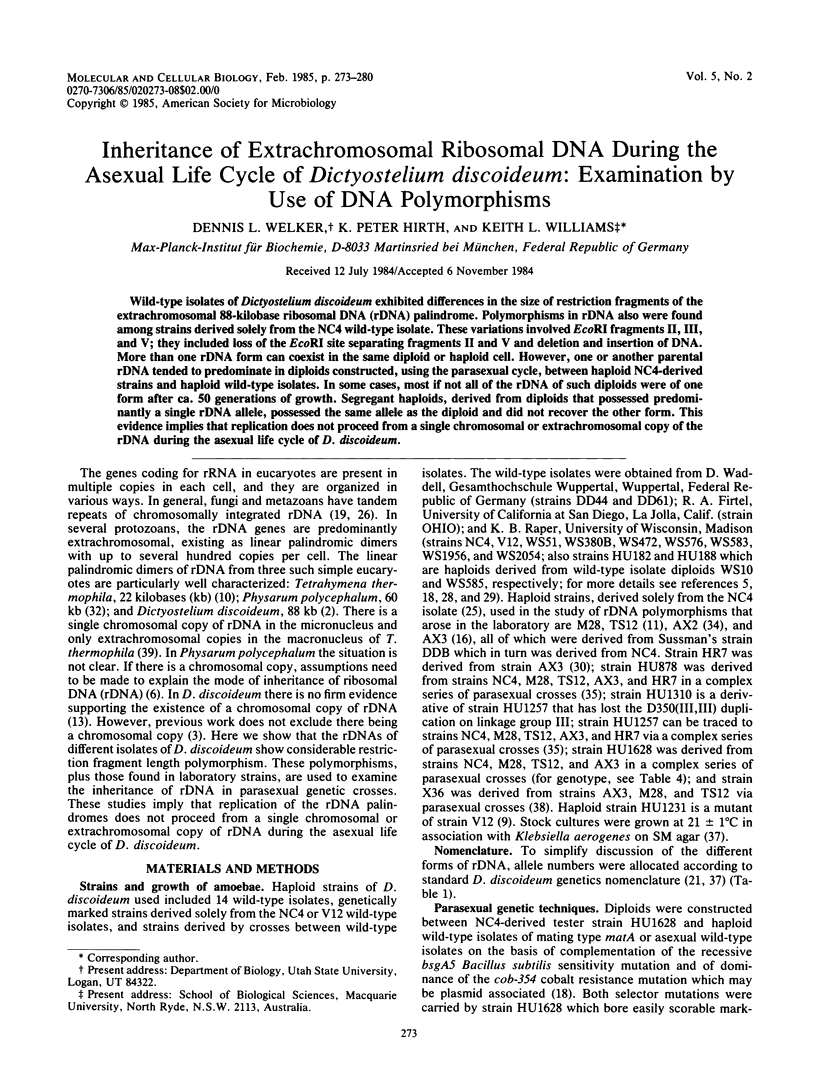
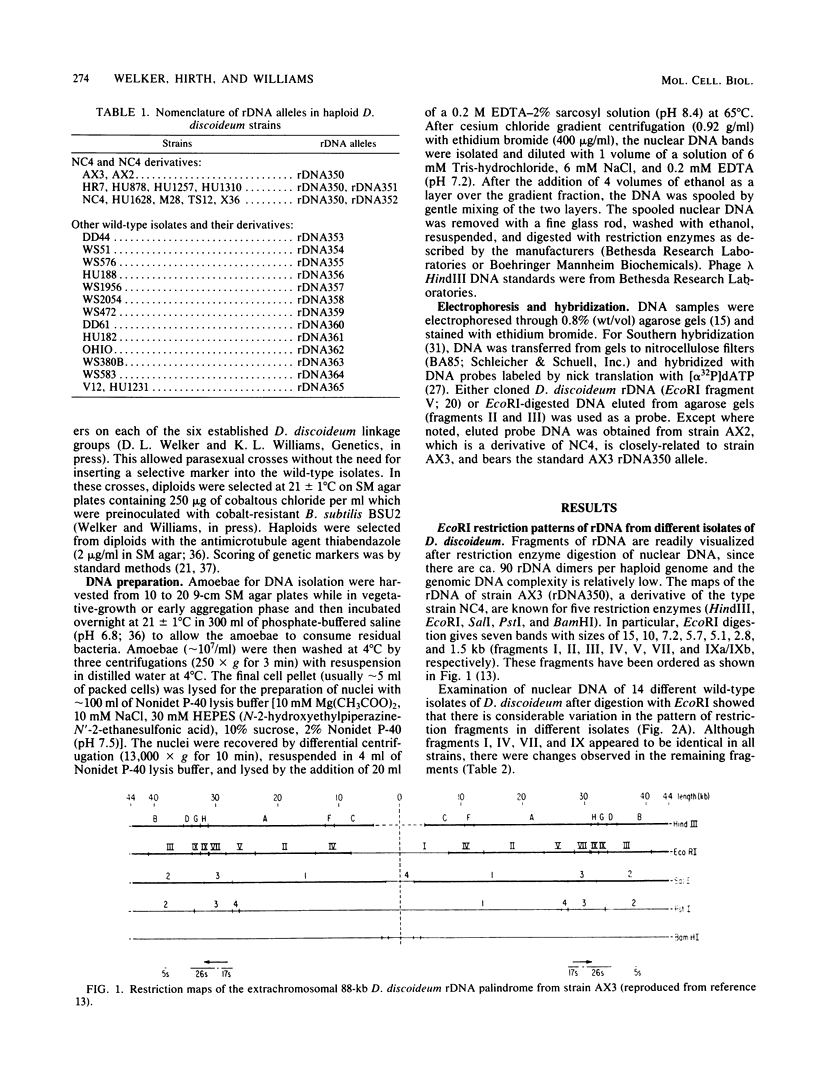
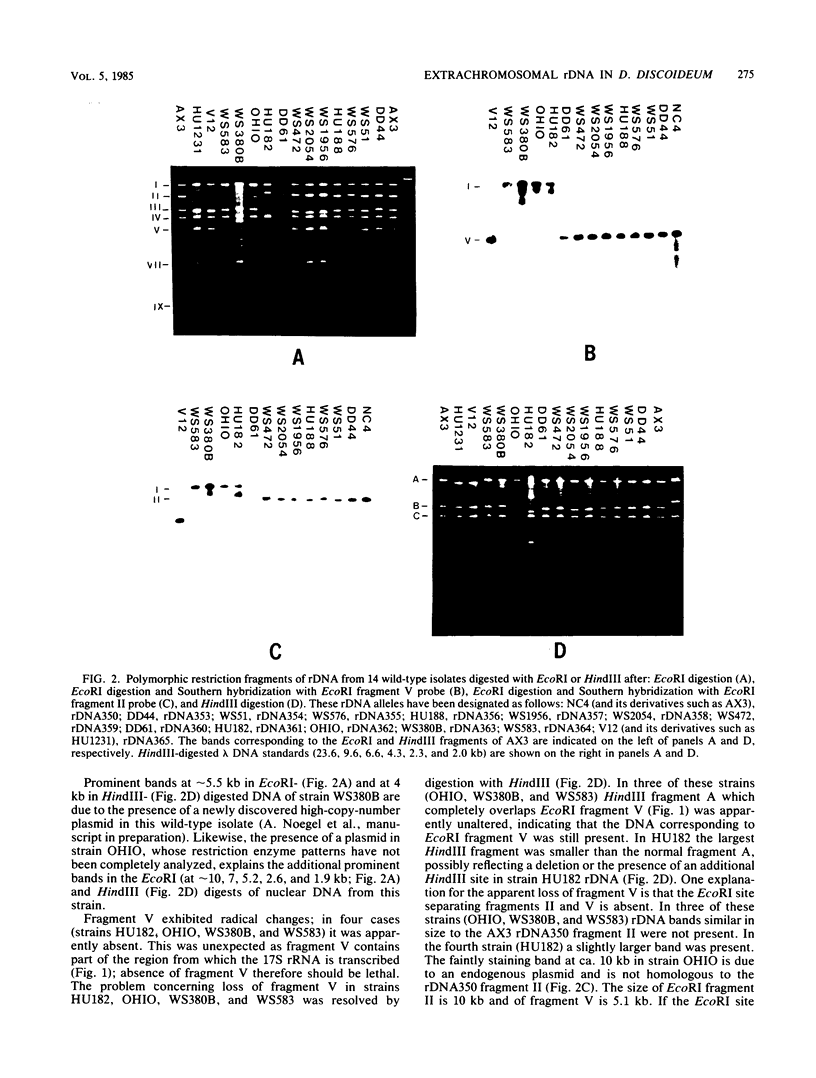

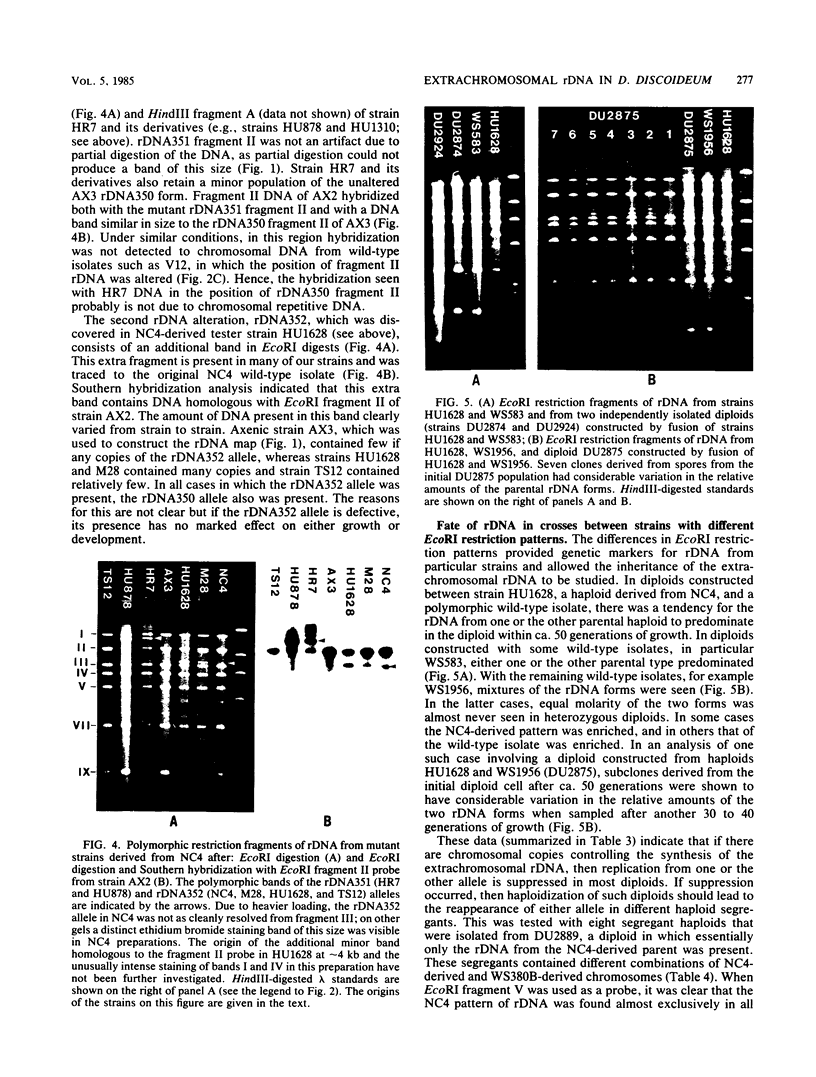
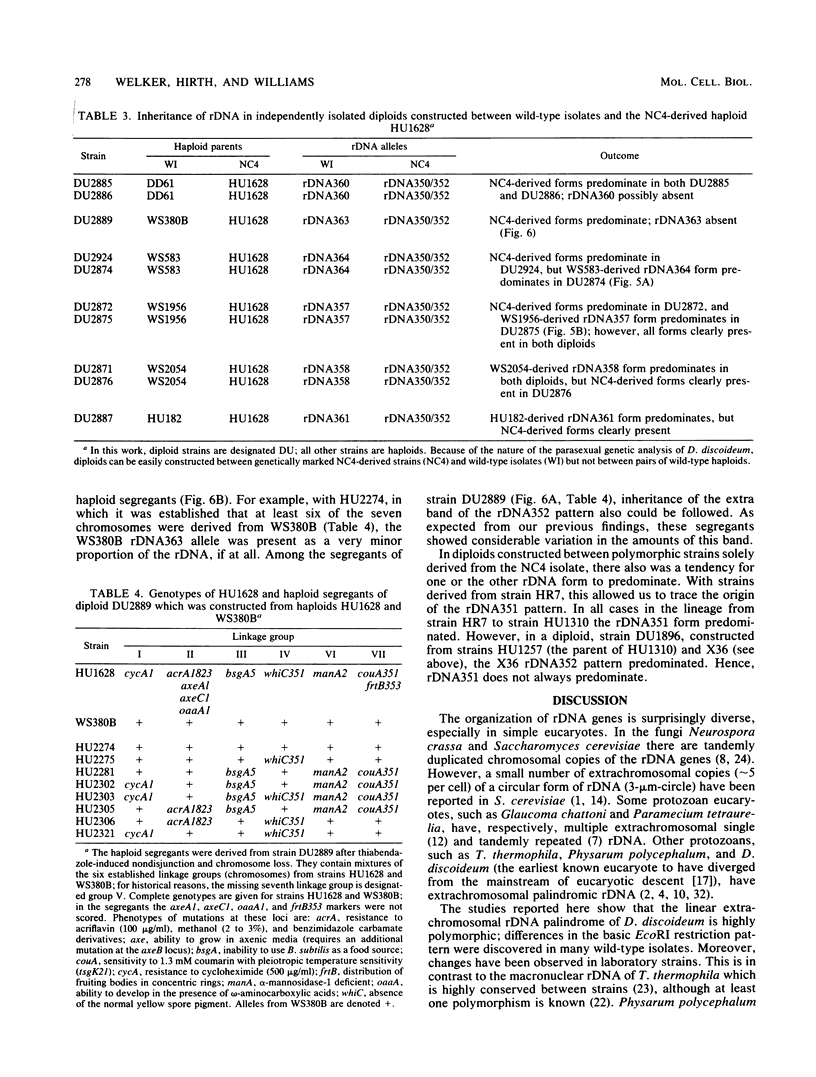
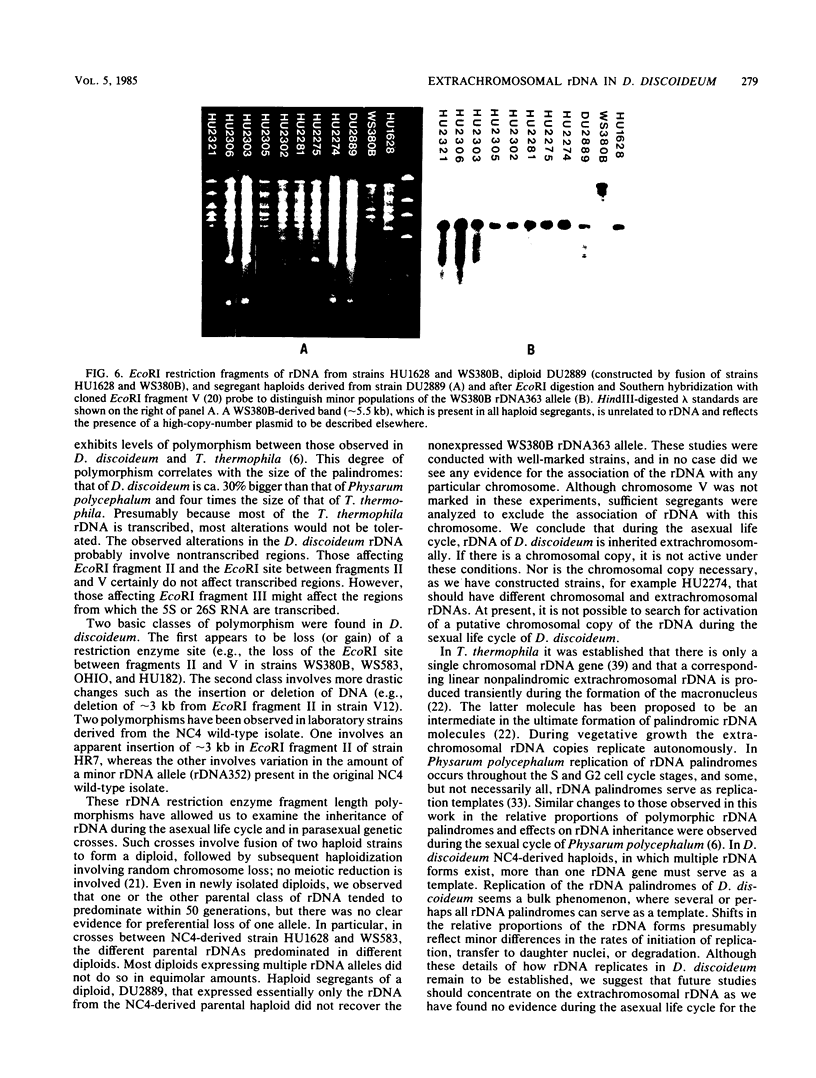
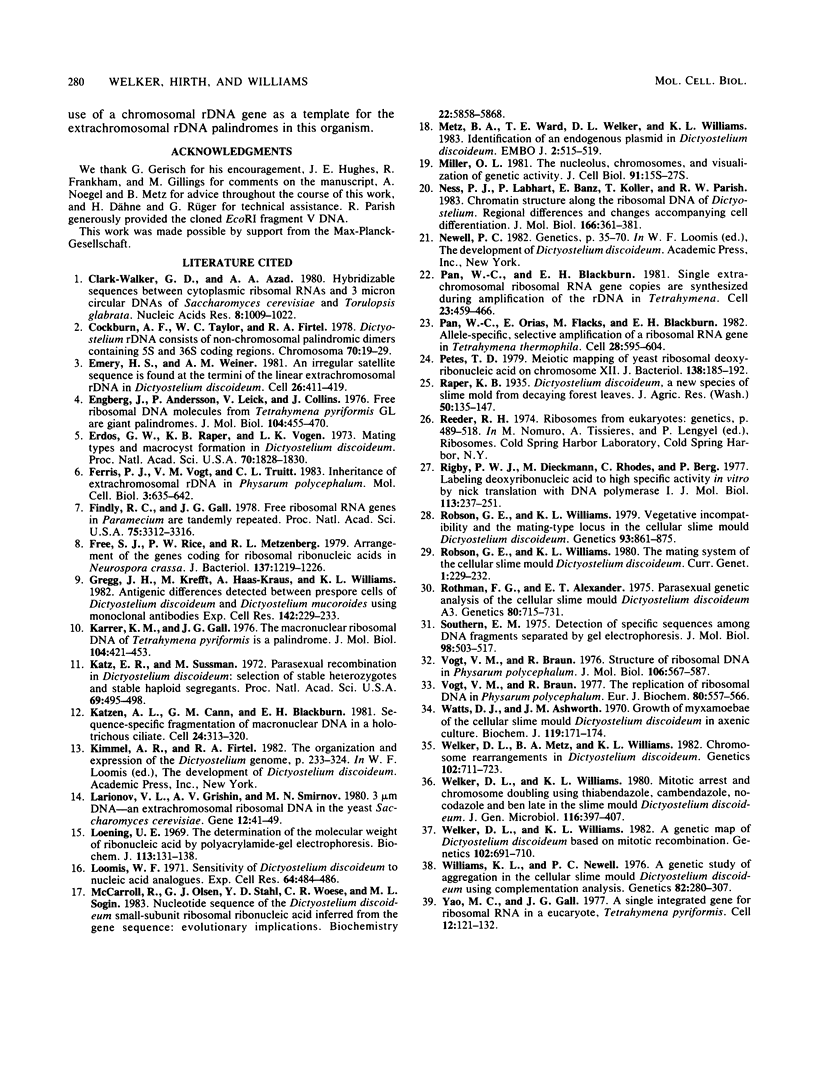
Images in this article
Selected References
These references are in PubMed. This may not be the complete list of references from this article.
- Clark-Walker G. D., Azad A. A. Hybridizable sequences between cytoplasmic ribosomal RNAs and 3 micron circular DNAs of Saccharomyces cerevisiae and Torulopsis glabrata. Nucleic Acids Res. 1980 Mar 11;8(5):1009–1022. doi: 10.1093/nar/8.5.1009. [DOI] [PMC free article] [PubMed] [Google Scholar]
- Cockburn A. F., Taylor W. C., Firtel R. A. Dictyostelium rDNA consists of non-chromosomal palindromic dimers containing 5S and 36S coding regions. Chromosoma. 1978 Dec 21;70(1):19–29. doi: 10.1007/BF00292212. [DOI] [PubMed] [Google Scholar]
- Emery H. S., Weiner A. M. An irregular satellite sequence is found at the termini of the linear extrachromosomal rDNA in Dictyostelium discoideum. Cell. 1981 Nov;26(3 Pt 1):411–419. doi: 10.1016/0092-8674(81)90210-5. [DOI] [PubMed] [Google Scholar]
- Engberg J., Andersson P., Leick V., Collins J. Free ribosomal DNA molecules from Tetrahymena pyriformis GL are giant palindromes. J Mol Biol. 1976 Jun 25;104(2):455–470. doi: 10.1016/0022-2836(76)90281-3. [DOI] [PubMed] [Google Scholar]
- Erdos G. W., Raper K. B., Vogen L. K. Mating Types and Macrocyst Formation in Dictyostelium discoideum. Proc Natl Acad Sci U S A. 1973 Jun;70(6):1828–1830. doi: 10.1073/pnas.70.6.1828. [DOI] [PMC free article] [PubMed] [Google Scholar]
- Ferris P. J., Vogt V. M., Truitt C. L. Inheritance of extrachromosomal rDNA in Physarum polycephalum. Mol Cell Biol. 1983 Apr;3(4):635–642. doi: 10.1128/mcb.3.4.635. [DOI] [PMC free article] [PubMed] [Google Scholar]
- Findly R. C., Gall J. G. Free ribosomal RNA genes in Paramecium are tandemly repeated. Proc Natl Acad Sci U S A. 1978 Jul;75(7):3312–3316. doi: 10.1073/pnas.75.7.3312. [DOI] [PMC free article] [PubMed] [Google Scholar]
- Free S. J., Rice P. W., Metzenberg R. L. Arrangement of the genes coding for ribosomal ribonucleic acids in Neurospora crassa. J Bacteriol. 1979 Mar;137(3):1219–1226. doi: 10.1128/jb.137.3.1219-1226.1979. [DOI] [PMC free article] [PubMed] [Google Scholar]
- Gregg J. H., Krefft M., Haas-Kraus A., Williams K. L. Antigenic differences detected between prespore cells of Dictyostelium discoideum and Dictyostelium mucoroides using monoclonal antibodies. Exp Cell Res. 1982 Nov;142(1):229–233. doi: 10.1016/0014-4827(82)90427-x. [DOI] [PubMed] [Google Scholar]
- Karrer K. M., Gall J. G. The macronuclear ribosomal DNA of Tetrahymena pyriformis is a palindrome. J Mol Biol. 1976 Jun 25;104(2):421–453. doi: 10.1016/0022-2836(76)90280-1. [DOI] [PubMed] [Google Scholar]
- Katz E. R., Sussman M. Parasexual recombination in Dictyostelium discoideum: selection of stable diploid heterozygotes and stable haploid segregants (clones-temperature sensitive-ploidy-fruiting bodies-spore-slime mold). Proc Natl Acad Sci U S A. 1972 Feb;69(2):495–498. doi: 10.1073/pnas.69.2.495. [DOI] [PMC free article] [PubMed] [Google Scholar]
- Katzen A. L., Cann G. M., Blackburn E. H. Sequence-specific fragmentation of macronuclear DNA in a holotrichous ciliate. Cell. 1981 May;24(2):313–320. doi: 10.1016/0092-8674(81)90321-4. [DOI] [PubMed] [Google Scholar]
- Larionov V. L., Grishin A. V., Smirnov M. N. 3 micron DNA - an extrachromosomal ribosomal DNA in the yeast Saccharomyces cerevisiae. Gene. 1980 Dec;12(1-2):41–49. doi: 10.1016/0378-1119(80)90014-1. [DOI] [PubMed] [Google Scholar]
- Loening U. E. The determination of the molecular weight of ribonucleic acid by polyacrylamide-gel electrophresis. The effects of changes in conformation. Biochem J. 1969 Jun;113(1):131–138. doi: 10.1042/bj1130131. [DOI] [PMC free article] [PubMed] [Google Scholar]
- Loomis W. F., Jr Sensitivity of Dictyostelium discoideum to nucleic acid analogues. Exp Cell Res. 1971 Feb;64(2):484–486. doi: 10.1016/0014-4827(71)90107-8. [DOI] [PubMed] [Google Scholar]
- Metz B. A., Ward T. E., Welker D. L., Williams K. L. Identification of an endogenous plasmid in Dictyostelium discoideum. EMBO J. 1983;2(4):515–519. doi: 10.1002/j.1460-2075.1983.tb01456.x. [DOI] [PMC free article] [PubMed] [Google Scholar]
- Miller O. L., Jr The nucleolus, chromosomes, and visualization of genetic activity. J Cell Biol. 1981 Dec;91(3 Pt 2):15s–27s. doi: 10.1083/jcb.91.3.15s. [DOI] [PMC free article] [PubMed] [Google Scholar]
- Ness P. J., Labhart P., Banz E., Koller T., Parish R. W. Chromatin structure along the ribosomal DNA of Dictyostelium. Regional differences and changes accompanying cell differentiation. J Mol Biol. 1983 May 25;166(3):361–381. doi: 10.1016/s0022-2836(83)80090-4. [DOI] [PubMed] [Google Scholar]
- Pan W. C., Blackburn E. H. Single extrachromosomal ribosomal RNA gene copies are synthesized during amplification of the rDNA in Tetrahymena. Cell. 1981 Feb;23(2):459–466. doi: 10.1016/0092-8674(81)90141-0. [DOI] [PubMed] [Google Scholar]
- Pan W. C., Orias E., Flacks M., Blackburn E. H. Allele-specific, selective amplification of a ribosomal RNA gene in Tetrahymena thermophila. Cell. 1982 Mar;28(3):595–604. doi: 10.1016/0092-8674(82)90214-8. [DOI] [PubMed] [Google Scholar]
- Petes T. D. Meiotic mapping of yeast ribosomal deoxyribonucleic acid on chromosome XII. J Bacteriol. 1979 Apr;138(1):185–192. doi: 10.1128/jb.138.1.185-192.1979. [DOI] [PMC free article] [PubMed] [Google Scholar]
- Rigby P. W., Dieckmann M., Rhodes C., Berg P. Labeling deoxyribonucleic acid to high specific activity in vitro by nick translation with DNA polymerase I. J Mol Biol. 1977 Jun 15;113(1):237–251. doi: 10.1016/0022-2836(77)90052-3. [DOI] [PubMed] [Google Scholar]
- Robson G. E., Williams K. L. Vegetative Incompatibility and the Mating-Type Locus in the Cellular Slime Mold DICTYOSTELIUM DISCOIDEUM. Genetics. 1979 Dec;93(4):861–875. doi: 10.1093/genetics/93.4.861. [DOI] [PMC free article] [PubMed] [Google Scholar]
- Rothman F. G., Alexander E. T. Parasexual genetic analysis of the cellular slime mold Dictyostelium discoideum A3. Genetics. 1975 Aug;80(4):715–731. doi: 10.1093/genetics/80.4.715. [DOI] [PMC free article] [PubMed] [Google Scholar]
- Southern E. M. Detection of specific sequences among DNA fragments separated by gel electrophoresis. J Mol Biol. 1975 Nov 5;98(3):503–517. doi: 10.1016/s0022-2836(75)80083-0. [DOI] [PubMed] [Google Scholar]
- Vogt V. M., Braun R. Structure of ribosomal DNA in Physarum polycephalum. J Mol Biol. 1976 Sep 25;106(3):567–587. doi: 10.1016/0022-2836(76)90252-7. [DOI] [PubMed] [Google Scholar]
- Vogt V. M., Braun R. The replication of ribosomal DNA in Physarum polycephalum. Eur J Biochem. 1977 Nov 1;80(2):557–566. doi: 10.1111/j.1432-1033.1977.tb11912.x. [DOI] [PubMed] [Google Scholar]
- Watts D. J., Ashworth J. M. Growth of myxameobae of the cellular slime mould Dictyostelium discoideum in axenic culture. Biochem J. 1970 Sep;119(2):171–174. doi: 10.1042/bj1190171. [DOI] [PMC free article] [PubMed] [Google Scholar]
- Welker D. L., Metz B. A., Williams K. L. Chromosome rearrangements in Dictyostelium discoideum. Genetics. 1982 Dec;102(4):711–723. doi: 10.1093/genetics/102.4.711. [DOI] [PMC free article] [PubMed] [Google Scholar]
- Welker D. L., Williams K. L. A genetic map of Dictyostelium discoideum based on mitotic recombination. Genetics. 1982 Dec;102(4):691–710. doi: 10.1093/genetics/102.4.691. [DOI] [PMC free article] [PubMed] [Google Scholar]
- Williams K. L., Newell P. C. A genetic study of aggregation in the cellular slime mould Dictyostelium discoideum using complementation analysis. Genetics. 1976 Feb;82(2):287–307. doi: 10.1093/genetics/82.2.287. [DOI] [PMC free article] [PubMed] [Google Scholar]
- Yao M. C., Gall J. G. A single integrated gene for ribosomal RNA in a eucaryote, Tetrahymena pyriformis. Cell. 1977 Sep;12(1):121–132. doi: 10.1016/0092-8674(77)90190-8. [DOI] [PubMed] [Google Scholar]



